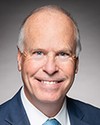Thank you, Mr. Barrett.
We'll go over to Ms. Lapointe for five minutes, please.
Evidence of meeting #107 for Industry, Science and Technology in the 44th Parliament, 1st Session. (The original version is on Parliament’s site, as are the minutes.) The winning word was chair.
A recording is available from Parliament.
7:40 p.m.
NDP

The Acting Chair NDP Brian Masse
Thank you, Mr. Barrett.
We'll go over to Ms. Lapointe for five minutes, please.
7:40 p.m.
Liberal

Viviane LaPointe Liberal Sudbury, ON
Thank you, Mr. Chair.
Ms. Lawrence, one of my learnings in organizational excellence is that you can have the best of policies written, but if they're not followed and if there's not a mechanism to monitor and check to see if they're being followed, then those policies don't carry much weight.
Can you talk to the committee about the official ethics guidelines that your organization was expected to follow? Can you also talk about the processes and mechanisms that were in place to ensure that those guidelines were properly followed, both by the board and by employees?
7:40 p.m.
Former President and Chief Executive Officer, Sustainable Development Technology Canada, As an Individual
There are two things—or probably three things.
When I started at SDTC in 2015, I was surprised to find that the conflict of interest policies for the employees and the board were actually the same. That is to say that employees actually were allowed at that point to have direct conflicts of interest. One of my first acts as CEO was to separate those two policies and ensure that there were no direct conflicts for employees. That continues to this day.
With respect to boards of directors, all a CEO can do is advise. The ethics policy for the board of directors had always had the ability for a board member to have conflicts. By the time I was appointed, most of the GIC appointees did not, but it had been a long-standing practice that the non-governmental appointees had managed conflict, as we have been talking about earlier.
The process in place is as follows: Before we go into an investment committee round, there are standing conflicts when people are appointed that are managed and are always looked at by the investment vice-president and director when we're going into a round.
The next thing that happens is there is a circulation well in advance of the meeting for boards of directors to declare if they have a conflict or a perceived conflict with a potential recipient of funds and consortia partners related to them. That has to be received back before the board members will receive any of the materials. If they declare a conflict, they do not receive the materials related to that declared conflict in the board package.
In the board package, all of the declarations are summarized and the chair would then call for any additions or any changes at the board meeting. Anybody who perhaps became aware of something between those dates could raise it at that time.
That's the process.
The idea is that these things would be minuted and followed up on as the case may be.
That's the process. It was followed in most cases. This was the managed conflict that we had in place.
7:40 p.m.
Liberal

Viviane LaPointe Liberal Sudbury, ON
I appreciate that was the policy, the expected practice, and that board members would need to recuse themselves. They would need to discuss conflict at the beginning of each meeting, but I believe the RCGT report clearly said that didn't happen. That's the adherence piece, where it may be written, but in practice, did that happen? The report indicates that it didn't.
Could you expand on that for the committee?
7:40 p.m.
Former President and Chief Executive Officer, Sustainable Development Technology Canada, As an Individual
I believe that SDTC filed with the ethics committee, and perhaps this one, that this process was filed. Perhaps the minutes didn't reflect it in an appropriate way and that's the problem. This process is and was followed.
7:40 p.m.
Liberal

Viviane LaPointe Liberal Sudbury, ON
What would be the role of the CEO in a situation where a board member doesn't recuse himself or herself, or doesn't declare a conflict of interest at that point?
7:40 p.m.
Former President and Chief Executive Officer, Sustainable Development Technology Canada, As an Individual
The role of the CEO is to work very closely with the governance chair. From 2015 to 2019, when Gary Lunn was the governance chair, we did that very actively. That time was an easier time, because, as was stated, we didn't have as many direct conflicts as we had after Annette Verschuren's appointment.
He and I would work together to approach board members to talk to them about perceived and real conflicts, and because of his gravitas as a former minister of the Crown, that often carried the day, and, actually, always carried the day. Once he was gone, and once we had a very different operating environment related to a direct conflict with Annette Verschuren's appointment, at that point all the CEO can do and the vice-president investments can do is recommend.
In most cases, the director would ask that the adjudication go to the committee or the committee chair. In some cases, if we felt strongly that it needed to be adjudicated before the committee, if it was a direct conflict, we would engage the committee chair. In other cases, where it was a perceived conflict, it would get discussed directly at committee.
7:45 p.m.
NDP

The Acting Chair NDP Brian Masse
Thank you very much.
We'll move to Mr. Garon, for two and a half minutes.
7:45 p.m.
Bloc

Jean-Denis Garon Bloc Mirabel, QC
Thank you very much, Mr. Chair.
We can see that it might be useful to amend the act that governs Sustainable Development Technology Canada. In the meantime, in the interest of restoring public confidence, if that's even possible, what can be done right now to improve not only the organization's governance but also public perception of that governance?
7:45 p.m.
Former President and Chief Executive Officer, Sustainable Development Technology Canada, As an Individual
First and foremost, I understand right now that the Government of Canada is going to be looking at appointing new board members, because there are some that will be retiring. What's important and must be done is that those new board members have no conflict of interest. That would be the one and first recommendation I would make.
7:45 p.m.
Bloc

Jean-Denis Garon Bloc Mirabel, QC
I'll just interrupt you there. Is it possible to find board members who don't have conflicts of interest?
7:45 p.m.
Former President and Chief Executive Officer, Sustainable Development Technology Canada, As an Individual
Definitely.
I signed off on the Auditor General review that was mentioned earlier. It was one of the last things I did before resigning from SDTC. That review will be very important. It will help bring together some of the threads in terms of the various agencies, actors and individuals, and what their roles and responsibilities should be in this kind of a governance model.
7:45 p.m.
Bloc

Jean-Denis Garon Bloc Mirabel, QC
What do you think are the main amendments that could be made to improve the situation? If you don't have time to share a list with us now, would you be willing to send written recommendations to the committee about changes that can be made right away and future legislative changes that could prevent this kind of situation from happening again?
7:45 p.m.
Former President and Chief Executive Officer, Sustainable Development Technology Canada, As an Individual
It would be my pleasure to follow up with that kind of information. I know that SDTC's staff, in negotiating contributions eight and nine, proposed such amendments to ISED as well, so they would be able to provide that information to you.
7:45 p.m.
NDP
7:45 p.m.
Conservative

Rick Perkins Conservative South Shore—St. Margarets, NS
Thank you, Mr. Chair.
If I have this right so far, in 2018-19, the former chair, Jim Balsillie, is speaking out publicly against the lack of movement by the government on its digital privacy policy. The government expresses concern to you, as chair, that he would be doing that and still be in this role. Shortly thereafter, the minister phones you and says, “We're going to change the chair. Here are two names.” You express reservations about one of them, who had a clear conflict of interest. Minister Bains and the Governor in Council, the cabinet, appoints her to this job anyway knowing there is a conflict of interest.
Is that correct?
7:45 p.m.
Former President and Chief Executive Officer, Sustainable Development Technology Canada, As an Individual
That's correct.
7:45 p.m.
Conservative

Rick Perkins Conservative South Shore—St. Margarets, NS
The person in constant contact with you personally as the CEO going back and forth to the ministry was ADM Noseworthy. Is that correct?
7:45 p.m.
Former President and Chief Executive Officer, Sustainable Development Technology Canada, As an Individual
I believe it was, yes, from 2018 on.
7:45 p.m.
Conservative

Rick Perkins Conservative South Shore—St. Margarets, NS
ADM Noseworthy said before this committee that he didn't recall any discussions of conflicts of interest around these.
Do you believe that to be a true statement?
7:45 p.m.
Former President and Chief Executive Officer, Sustainable Development Technology Canada, As an Individual
What I know is that the materials were circulated to ADM Noseworthy and his team before every meeting. I know that conflict was discussed at every meeting. In my recollection, Mr. Noseworthy was in those meetings.
7:45 p.m.
Conservative

Rick Perkins Conservative South Shore—St. Margarets, NS
Before this committee, deputy minister Simon Kennedy said he was not aware of any of the conflicts until the whistle-blower came to him in 2023.
Do you think it's possible for the minister's office to appoint somebody when they've been notified of a conflict by the associate deputy minister, who presumably reports to the deputy minister? The deputy minister talks to the minister. Could the deputy minister claim he didn't know about these conflicts? Does that make any sense to you?
7:50 p.m.
Former President and Chief Executive Officer, Sustainable Development Technology Canada, As an Individual
I cannot speak about Deputy Minister Kennedy, because he was not the deputy at the time of Annette's appointment. That happened after.
7:50 p.m.
Former President and Chief Executive Officer, Sustainable Development Technology Canada, As an Individual
It was John Knubley.